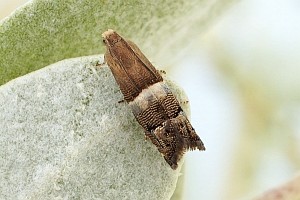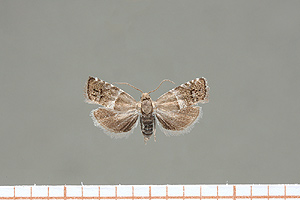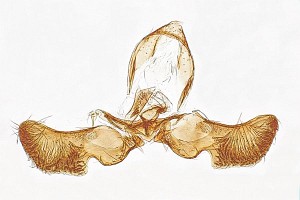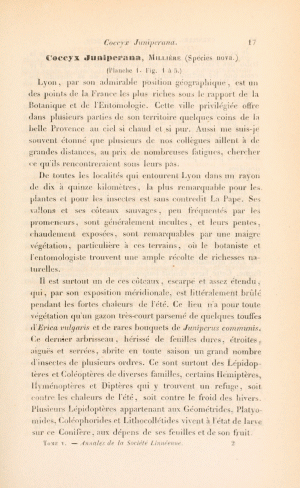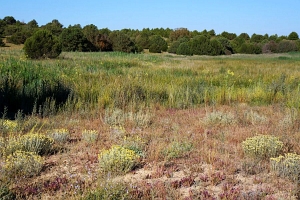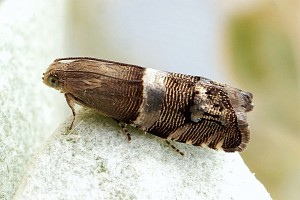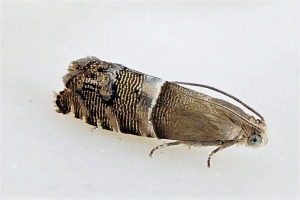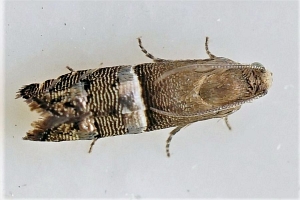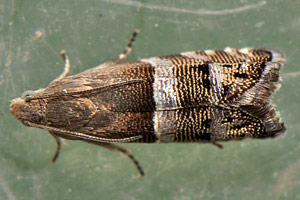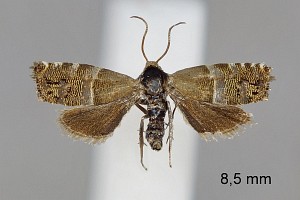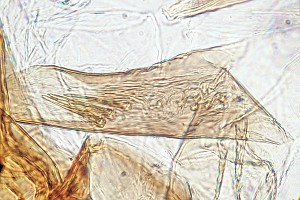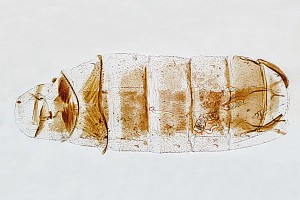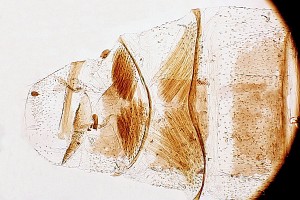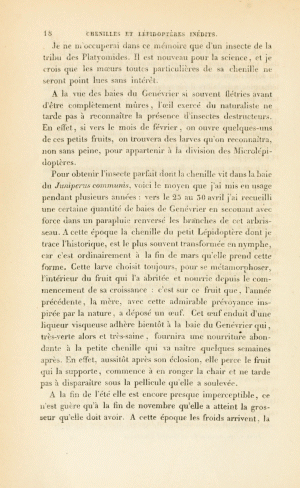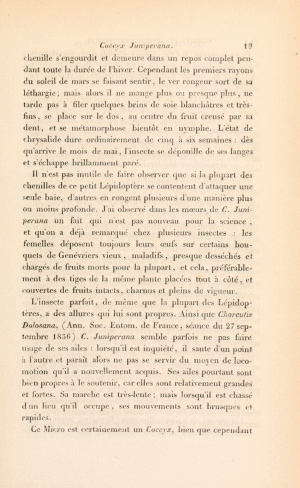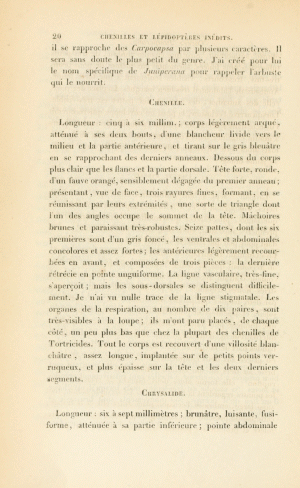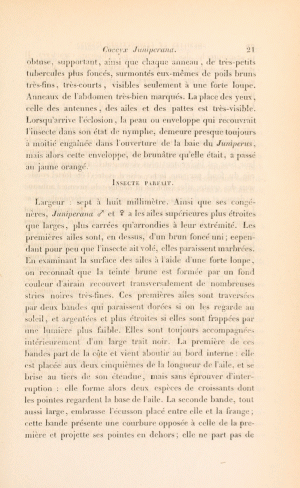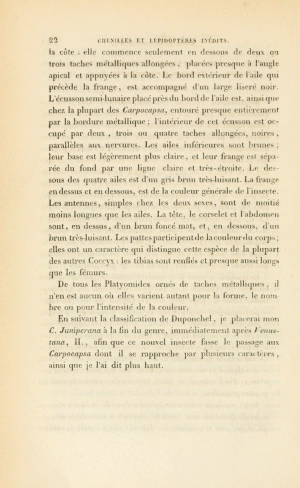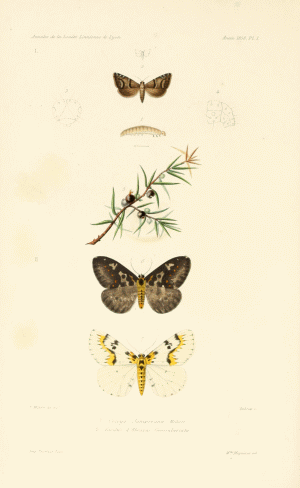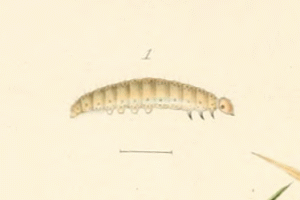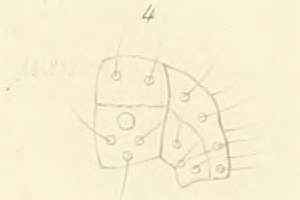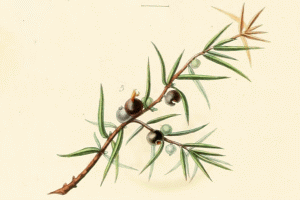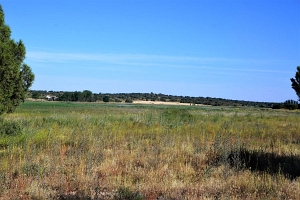

 +9Kontinente:EU
+9Kontinente:EU1. Lebendfotos
1.1. Falter
2. Diagnose
2.1. Männchen
2.2. Genitalien
2.2.1. Männchen
2.3. Erstbeschreibung
3. Biologie
3.1. Habitat
3.2. Nahrung der Raupe
- [Cupressaceae:] Juniperus communis (Gewöhnlicher Wacholder)
- [Cupressaceae:] Juniperus foetidissima (Stinkender Wacholder)
- [Cupressaceae:] Juniperus thurifera ? (Spanischer Wacholder ?)
- [Cupressaceae:] Juniperus oxycedrus ? (Stech-Wacholder ?)
- [Cupressaceae:] Juniperus cedrus ?? (Zedern-Wacholder ??)
Bereits Millière (1858: 17-22, 47, pl. 1 fig. 1-5) kannte die Raupe seiner neuen Art bestens - er fand sie in den Beeren des Gewöhnlichen oder Gemeinen Wacholders.
Moraiti et al. (2019) untersuchten auf Zypern tierische Bewohner der "Berries" von Juniperus foetidissima. Drei Arten von Microlepidoptera wurden per Barcode-Bestimmung zugeordnet: "Nine individual microlepidopteran larvae were isolated from infested berries collected by cutting and were used for molecular characterization and typing. [...] Larvae of a size allowing identification of Pammene spp. were collected from mid-July onwards, while for A. aurulentella from mid-August. Usually, berries were infested with just one larva, but in some cases, we retrieved 2 or 3 larvae of A. aurulentella per berry. [...] DNA barcoding Sequencing data were deposited in the NCBI GenBank database with Accession Numbers of KY989993-KY989995 and MF001914-MF001919. DNA BOLD (http://www.boldsystems.org/) identification results for four samples revealed 99.5–99.8% similarity with Pammene mariana (Zerny) (Lepidoptera: Tortricidae) from Bulgaria (BOLD sample IDs: BTLBP369–11 and BTLBP370–11). Two samples (CYPAM19-MF001918 and CYPAM14- MF001919) showed 98.3% similarity proximity with Pammene juniperana (Millière) (Lepidoptera: Torticidae) (BOLD sample ID: FGMLH474–16) from Germany. Finally, the mtCOI sequence of three other Lepidoptera samples (LEP1CY- KY989993, LEP2CY- KY989994 and LEP3 CY- KY989995) showed 99% homology with Argyresthia aurulentella reported in Bulgaria, Italy, Finland and UK (Bold sample IDs GMBUE3154–14, GMFIG616–12, LASTS819–15, CGUKD606–09, respectively)."
[bladmineerders.nl (abgefragt 17. August 2023)] führt noch Juniperus cedrus (Zedern-Wacholder), Juniperus oxycedrus (Stech-Wacholder) und Juniperus thurifera (Spanischer Wacholder) an. Wie gut abgesichert diese Angaben sind, bleibt unklar: J. cedrus ist eine Art der Kanaren und von Madeira, wo P. juniperana fehlt - die Beobachtung stammt also aus einem Garten, oder aber die Angabe ist falsch. Bei J. oxycedrus ist unklar, wie gut gegenüber Pammene oxycedrana abgegrenzt wurde.
(Autor: Erwin Rennwald)
4. Weitere Informationen
4.1. Andere Kombinationen
- Coccyx juniperana Millière, 1858 [Originalkombination]
4.2. Synonyme
- Pammene thuriferana Cleu, 1926
- Tortrix tergorana Frölich, 1828
4.3. Faunistik
Nach Bryner et al. (2004) kommt die Art in der Schweiz vor.
Nach Gaedike & Heinicke (1999) in Deutschland nur mit Angaben von vor 1980 aus Hessen, Niedersachsen und Thüringen bekannt.
Moraiti et al. (2019) melden die Art erstmals für Zypern.
(Autor: Erwin Rennwald)
4.4. Literatur
- Gaedike, R. & W. Heinicke (1999): Verzeichnis der Schmetterlinge Deutschlands (Entomofauna Germanica 3). — Entomologische Nachrichten und Berichte, Beiheft 5: 1-216.
- Erstbeschreibung: Millière, P. (1858): Iconographie et description de chenilles et lépidoptères inédits. — Annales de la Société Linnéenne de Lyon. N. S. 5: 15-50 + pl. 1-4.
- Moraiti, C.A., Kadis, C., Papayiannis, L.C. & M.C. Stavrinides (2019): Insects and mites feeding on berries of Juniperus foetidissima Willd. on the Mediterranean island of Cyprus. — Phytoparasitica, 47 (1): 1-7. https://doi.org/10.1007/s12600-019-00718-1. [zum PDF-Download der online-first-Version auf researchgate.net]










